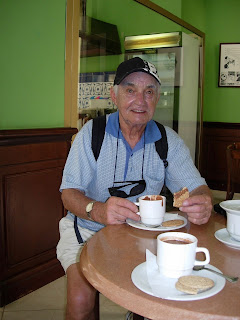Casa Esther, Havana, June 2009
Esther, our host at Casa Esther in Havana, asked us a rhetorical question: How much do you think it would cost to restore Havana? We agreed it would be billions. They have made a start, and in the centre of Havana, there is a series of panels showing spots in Warsaw after the bombing, and then the same spots – with the same people superimposed – after restoration. This is to give courage, I suppose.
Esther, our host at Casa Esther in Havana, asked us a rhetorical question: How much do you think it would cost to restore Havana? We agreed it would be billions. They have made a start, and in the centre of Havana, there is a series of panels showing spots in Warsaw after the bombing, and then the same spots – with the same people superimposed – after restoration. This is to give courage, I suppose.
These last few days, still unable to eat, I have lived on ice cream – it is
good, and, just as in the film, the flavours are chocolat and fresia
(strawberry) – plus very nice lemonade and lime fizzy drinks. We did try a
little restaurant food, and Bill, a former chef, told the waiting staff that
regretfully he had not enjoyed it. I felt sorry for them, as it was not their
fault. The Cuban-style Chinese meal included won ton soup that appeared to be hot water with won ton dough but no filling.
We
saw long queues of people waiting to buy the big red apples that appeared one
day. Bill said it reminded him of wartime Britain: the Government would
suddenly allow a shipment of some rarely seen food, and people would queue to
buy it.
In
the busy Calle Raphael, which we've walked along each day from Casa Esther,
we've seen many Habaneros enjoying pizza and other snacks that can be bought on the
street. This part of Cuba is rather rough, but full of the sights and sounds of
Cuba.
Rather
belatedly we discovered the picturesque boulevard, Paseo del Prado, which is
lined with restored buildings, and has a wide public space in the centre with cool marble, shady trees, statues of lions, artists selling their work (aimed
mostly at tourists; far less interesting than what we saw in Trinidad), and
people out and about enjoying themselves. We popped into the historic Hotel
Sevilla, which has a gallery of photos of the greats who have stayed and
visited here.
In
Habana Vieja, we've walked several times along Mercaderes, one of the restored
streets. At the Museo de Chocolate we had a cup of hot chocolate with a dipping
biscuit.
 |
| Bill Barrie enjoying hot chocolate with a dipping biscuit, Museo de Chocolat, Havana. 2009 |
We
also stumbled across Simon Bolivar House. Simon Bolivar was the great liberator
of South American countries. A lovely young woman gave us a tour of the museum, which includes an enchanting series of modelled figures of Bolivar at all
stages of his life – some of them interestingly explicit. The guide asked if we
would return next day to collect a letter to post to her friend in Masterton.
We went to considerable effort to do so, and also brought a cake of soap for
her, but she was not there.
On
our last full day in Cuba we took advantage of the Habana Bus Tour, a series of
buses that let you travel round greater Havana from the beaches in the east to
the Hemingway Marina. The first bus drove east through the tunnel under the
harbour entrance, past the Morro Castle and on to the Playas del Este, where
Habaneros with some money go to swim, sunbath and relax on their day off. It
was very hot. We bought a cool drink, sought some shade, and I paddled in the
warm water. The second bus headed west around the perimeter of the vast
Cristobel Colon Cemetery.
I
am still unwell, and Bill feels ready to leave Cuba, but what a
fascinating two weeks we have had.
 |
| Bill purchased Cuban cigars to take to our neighbour, Kerry. Photo: Ann Barrie 2009 |
Letter
14 – Montreal
Arriving
in Montreal direct from Havana required quite an adjustment. We started the day sitting round
the table at Casa Esther, eating our usual breakfast of fresh fruit and juice,
eggs, and lightly toasted bread (which somehow neither of us could eat);
watching Esther’s mother cutting paper napkins in half, because they are
expensive; and experiencing the sounds and smells of Cuba that drifted in from
outside. And we ended the day at Au Git’ Anne in the heart of the Latin quarter
of Montreal. We walked to the grocery store at the end of the street and found
it amazingly well-stocked – real milk in many varieties, rows of cheeses,
strawberries, raspberries and many other beautiful fruits. In Cuba we seldom saw
fruit for sale, although we knew it was grown there, because we saw orange groves and bought little packets of delicious Cuban fruit juice (peach nectar was my
favourite).
Our host Anne
has been to Cuba twice, because fares are cheap, and she feels the need to escape
the harsh Canadian winter, especially since she suffers from arthritis. She
heads for the beach at Varadero, finds somewhere self-catering, and bribes the
maid to find her some decent food to cook. …
I
will blog about Bill’s and my stay in Montreal another time.
Blog
by Ann Barrie







I'm glad you enjoy my blog, Rachel. I'm not planning to go to India at present, but your trip would have been most interesting. Regards, Ann
ReplyDelete